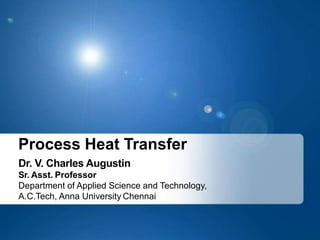Heat transfer can occur via three modes: conduction, convection, and radiation. Conduction involves the transfer of energy between adjacent particles in solids, liquids, and gases due to temperature differences. Convection refers to the transfer of heat by the movement of fluids and involves both conduction and fluid motion. Radiation is the emission and transmission of electromagnetic waves from the surface of an object as a result of its temperature. The key modes of heat transfer are analyzed using concepts such as the thermal conductivity of materials, heat transfer coefficients, and Stefan-Boltzmann's law of thermal radiation.




















![Thermal Conductivity – Points to remember
• It’s a physical property of a substance. k=f(temp, position, nature of the
substance, pr.[gases only])
• For isotropic material, kx=ky=kz=k (Properties of a material are identical in all directions)
• k is higher for pure metals. For alloys k is less than that of pure metals
• The k of liquids and gases is smaller than that of solids because of their larger
intermolecular spacing
• k is very low for gases and vapours; insulating materials and inorganic liquids
have k that lie in between those of metals and gases
• The k for most pure metals (except aluminium and uranium) decreases with
increasing temperature
• Air is a bad conductor of heat (0.022 W/mK)
• The k of a gas increases with increasing temp. and decreasing mol. wt.
• Super conductors are materials having high k at very low temp (eg: k for
Page 10
aluminium at 10 K is 20,000 W/mK whereas at 293 K is 175.6 W/mK only](https://image.slidesharecdn.com/pht080322-230724034331-fabeed47/85/PHT-080322-pptx-21-320.jpg)


























































































